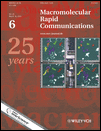New Developments in Multidimensional Chromatography of Complex Polymers
Abstract
Summary: Complex polymers are distributed in more than one direction of molecular heterogeneity. In addition to the molar mass distribution, they are frequently distributed with respect to chemical composition, functionality, and molecular heterogeneity. One approach for the analysis of the heterogeneity of complex polymers is their chromatographic separation by combining different separation mechanisms. A typical experimental protocol includes the separation of the sample according to composition to yield fractions that are chemically homogeneous. These fractions are transferred to a size-selective separation method and analyzed with respect to molar mass. As a result of this two-dimensional (2D) separation, information on both types of molecular heterogeneity is obtained. So far, 2D chromatography has been applied mostly to polymers that are soluble in organic solvents. There are several problems related to the use of aqueous mobile phases in polymer chromatography. These problems relate to the very polar or ionic character of the polymers and the experimental conditions, including the use of salt-containing eluents. The present paper addresses the different parameters that influence the chromatographic experiments. For a model polymer system resulting from the grafting of methacrylic acid (MAA) onto poly(ethylene glycol) (PEG), i.e., PEG-g-PMAA, it will be shown that different chromatographic techniques including SEC, LC-CC, and 2D chromatography, as well as coupled LC-CC/FT-IR can be used to analyze the molecular complexity of the copolymers.




